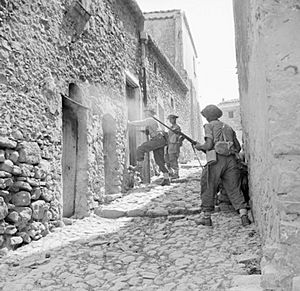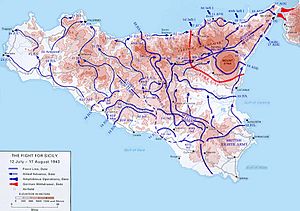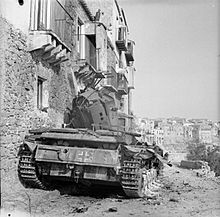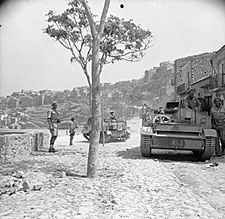Battle of Centuripe facts for kids
Quick facts for kids Battle of Centuripe |
|||||||
|---|---|---|---|---|---|---|---|
| Part of the Allied invasion of Sicily | |||||||
 Men of the 6th Battalion, Royal Inniskilling Fusiliers during mopping up operations in Centuripe. |
|||||||
|
|||||||
| Belligerents | |||||||
| Commanders and leaders | |||||||
| Strength | |||||||
|
|||||||
The Battle of Centuripe was a major fight during World War II. It happened in Sicily from August 2 to 4, 1943. This battle was part of the larger Allied invasion of Sicily.
British soldiers from the 78th Battleaxe Division fought hard. They faced German forces around the town of Centuripe. This town was in the middle of Sicily, in a hilly area. Centuripe was built on a very high, rocky peak. Only one steep, winding road led to it. Taking Centuripe was very important. It would help the Allies move forward and force the Germans to retreat. The British troops won the battle. This made the Germans start thinking about leaving Sicily completely.
Background to the Battle
Centuripe was a key spot in the German defense line across Sicily. It was a village perched on top of very steep hills. Its high, rocky sides made it almost impossible to attack. The smaller hills around Centuripe were also well defended by the Germans. The British needed to capture these smaller hills first. Only then could they try to take Centuripe itself.
The German forces defending this area were from the Hermann Göring Division. This group included the 3rd Fallschirmjäger Regiment. They also had artillery and some tanks with supporting infantry. Their commander was Ludwig Heilmann.
The British 78th Battleaxe Infantry Division prepared for their attack. Their goal was to move towards Catenanuova and capture Centuripe. This was part of a plan called Operation Hardgate. The land between the two villages was wild and rough. It had large rocky cliffs, similar to places the 78th Division had fought in Tunisia. This difficult land covered the only mountain road.
Major-General Vyvyan Evelegh led the 78th Division. He ordered Brigadier Nelson Russell to take Centuripe. Russell commanded the 38th (Irish) Infantry Brigade. The plan was to attack at night. They would have strong artillery support ready. The 6th Battalion, Royal Inniskilling Fusiliers and the 1st Battalion, Royal Irish Fusiliers had the main attack roles. The 2nd Battalion, London Irish Rifles were ordered to make a risky move around the side of the enemy.
On the evening of August 1, the London Irish soldiers moved into position. They hid in the dry riverbeds below Centuripe's foothills. No vehicles could reach them. This meant all supplies, like ammunition and food, had to be carried by hand. This caused a delay in their preparations.
The Battle Unfolds
At noon the next day, the London Irish moved forward. They were behind the 6th Battalion, Queen's Own Royal West Kent Regiment. This unit was fighting in the hills behind Centuripe. In the hot August sun, the London Irish could see Centuripe resting on the top of the large hill.
The London Irish had to capture three important hills. These were named Points 704, 611, and 703. They were behind Centuripe. The British didn't know how many German soldiers were on these hills. They hoped the Germans would be focused on the main battle. They thought the Germans might not pay much attention to their rear.
The London Irish G and F Companies began their attack. This was after a fifteen-minute artillery barrage from 25-pounder guns. They quickly reached Point 704. G Company took the position. Then, H Company moved to take Point 703. They faced machine-gun fire from the hill and its sides. G Company helped to silence this crossfire. When darkness came, the London Irish secured their new positions.
However, the third hill still held out. The British had to decide. Should they wait for it to fall? Or should they continue the attack without delay? They decided to keep going. They hoped the Germans would be too busy with the attack on their left side. The Royal Irish Fusiliers then attacked the north and rear of Centuripe. The Inniskillings had been fighting the Germans head-on. After a heavy artillery attack, they managed to get a foothold on the southern edge of the village. This involved climbing a 100-foot cliff.
The Royal Irish Fusiliers pushed through the northern part of the town. The fighting was tough and stubborn. Two German Panzer MKIII tanks caused the most problems. The British had no tanks to support them. These German tanks were eventually destroyed by PIAT weapons. The Irish Brigade then had the difficult job of fighting house to house. This was hard against the tough German paratroopers. By evening, they thought the town was clear. But the Germans counterattacked. Most of this attack was stopped. However, some German units slipped back in. They sniped at the Irish soldiers as they cleared the streets and houses.
Throughout the night, more soldiers from the 38th Brigade moved into the town. They came to help those already fighting there. Finally, the Germans launched another counterattack. But this one was weak and easily pushed back. After this, German resistance began to fade.
Just before dawn on August 3, the entire area, including Centuripe, fell to the Irish Brigade. This operation had been very difficult. It took place in challenging terrain. The Inniskillings deserved much credit for the success. They did most of the hard fighting.
After Centuripe was captured, the fighting didn't stop. The Irish Fusiliers took the high ground beyond the village. The London Irish marched through Centuripe. They reached higher ground overlooking the River Salso. Transport vehicles had trouble getting down the winding road from Centuripe. A large crater took twelve hours for engineers to fill. Also, the retreating Germans had left mortar bombs and shells scattered in the area.
Aftermath of the Victory
The successful capture of Centuripe caused the entire German defense line to break. This line stretched to Catania. The Germans had to pull back to a new position called the Etna line. However, they soon had to give up on this line too. Plans were quickly made to leave the island of Sicily entirely.
The London Irish quickly reached high ground on the other side of the Salso River. At night, 'E' and 'F' Companies reached the Simeto River. As dusk came, two platoons of 'G' Company crossed the river. They brought extra ammunition, mortars, and machine-guns. These were for immediate support of the other two companies. By dark, the river crossing point was secure. The Germans pulled back during the night. In the morning, a British patrol found the Germans halfway up the hills. On top of these hills was the next target: the town of Adrano, which had been bombed a lot.
However, taking Adrano was not a job for the Irish Brigade. Two other brigades (11th and 36th) from the 78th Division went through to capture it. From the afternoon of August 1 to the night of August 5, the Irish Brigade had advanced twenty-five miles. They fought battles at Centuripe, Salso, and the Simeto River.
The battalion rested for five days in the cool waters of the Simeto. By this time, the rest of the division had captured Aderno and Bronte. They were holding the hills on the far side of Bronte. Crossing the Salso and Simeto Rivers and the fall of Aderno cut off all German communication lines. These lines were west and south of Mount Etna. This also led to the fall of Paterno, Santa Maria, and Biancavilla. Meanwhile, the 1st Royal Irish Fusiliers had captured Capella and Monte Maletto. They also cleared the village. The fall of Maletto and the quick approach to Randazzo forced the Germans into their final hurried retreat to the sea.
News of Centuripe's capture was met with great excitement. General Bernard Montgomery, the commander of the British Eighth Army, saw the cliffs of the town after it was captured. He shouted impossible! The British Prime Minister, Winston Churchill, mentioned the news in the House of Commons a few days later. He called the capture one of the greatest achievements in storming a position.




